A woman knocked on our door one summer evening in 1992. She was circulating a petition against the planned construction of a huge arcade and mini-golf course not far from our neighborhood. As a Concerned Citizen, she felt that it would lower property values and promote delinquency in the delicate suburban environs of Beavercreek, Ohio.
I feel bad for that woman. Not only did my father, a man so cautious he balked at giving his credit card to Blockbuster, decline to put his name on the petition, but her visit guaranteed that arcade one more customer: I couldn’t wait to visit Cap’N Bogey’s Golf & Games.

Cap’n Bogey’s was close enough to our neighborhood to worry overprotective homeowners, and that meant it was within easy walking distance. Every weekend I’d hike there, usually early enough to avoid major crowds, and spend far too much time lost in a maze of arcade cabinets. My sister would tag along, but I’d make her walk a good distance behind me. Because you needed to look as cool as possible when you arrived at Cap’n Bogey’s.
There were many arcades in the Dayton suburbs, but compared to the typical nook in a mall or the back room at a pizza joint, Cap’n Bogey’s wasn’t just an arcade. It was a kingdom. The main building surrounded itself with a golf course, bumper-boats, and batting cages. Inside, the first floor was devoted to a snack bar and redemption games, with everything decorated in white, blue, and occasionally pink. I usually walked past such juvenile distractions and made straight for the upper level and the genuine arcade games.
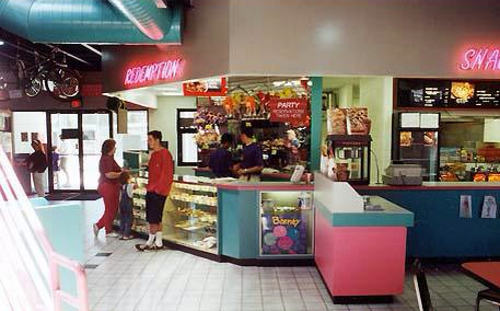
This was the 1990s, and that put me right in the middle of the fighting-game craze. Street Fighter II had started it in 1991, Mortal Kombat had cemented it in 1992, and within a few years every arcade had a wealth of head-to-head fighters and the coin-op industry was bigger than it had been since the early 1980s.
Cap’n Bogey’s arcade was stocked with every genre, including four sit-down Dayton USA cabinets, two T-Mek machines wired for versus play, the elaborate foot-pedal setup of Time Crisis, and the glorious driving-shooting hybrid of Lucky & Wild. Yet it was the fighting games that drew me. The gaming magazines of the day couldn’t stop hyping up the latest Street Fighter or Darkstalkers or Samurai Shodown or Virtua Fighter, and the first place to see them was the arcade. This was well before consoles were on par with arcade hardware, and unless your parents bought you a $600 Neo Geo home system, the arcade versions were always just a little bit better.
Some of these games would vanish within a month, but the big names stayed and took me through the heights of an arcade renaissance and its whimper of an ending.
KILLER INSTINCT
Is Killer Instinct the best fighting game of the 1990s? Hardly, but I think it’s the best example of a 1990s fighting game. Rare and Nintendo fashioned it with CG-rendered visuals that looked impressive in early 1995 but awkwardly plastic by that September. The game boasted every possible stereotype in its lineup: a Predator-like robot, a mystically powered ninja, a boxer, a velociraptor, a low-detail ice alien, an equally low-detail fire mutant, and, of course, a female character whose signature finishing move involved pulling open her top to give her opponent a heart attack. I'd say that the 1990s were a different time, but in this case I'm not sure that applies.
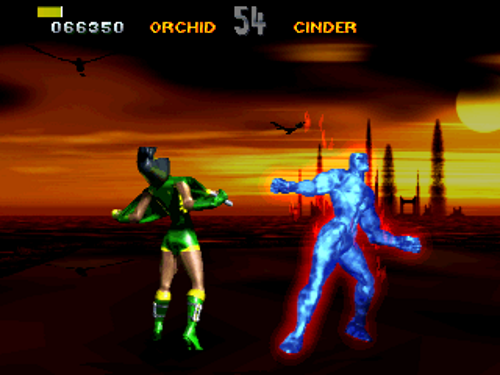
I actually learned to play fighting games on Killer Instinct. I’d enjoyed Street Fighter II and Mortal Kombat, but I was never particularly good at them, rarely pulling off a special move more complicated than jamming a button really fast. Killer Instinct was approachable enough that I could pull off the special moves and even trigger the extended combo attacks that made the game’s announcer yell BLASTER or AWESOME. And when I went back to playing Street Fighter Alpha or The King of Fighters ’95, I actually understood what was happening.
There’s a better reason I remember Killer Instinct well. One Saturday, local radio station Z-93 set up a contest with a Super NES and the newly released port of Killer Instinct. The previously selected participants didn’t show, so the station held a quick lottery and drew names of five random arcade patrons. I threw my name in and, thanks to the relatively light crowd, I got picked.
The contest wasn’t an actual tournament. Instead of facing each other, the five of us just played solo, using the ninja Jago, to see who could rack up the highest score in a single match. This was clearly planned by someone who still thought that video games were in the score-driven heyday of Pac-Man and Space Invaders, even though an actual fighter like Killer Instinct was all about beating an opponent and showing off an ULTRA combo.
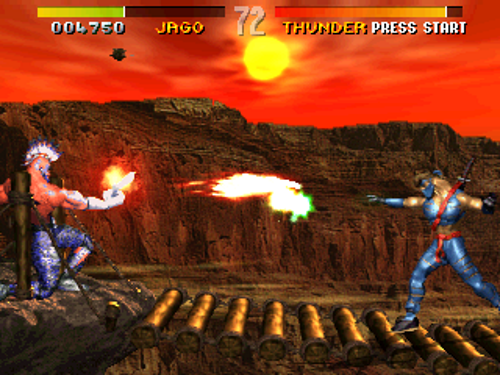
And I won. I managed to perform a bunch of combos and Jago’s finishing move, which put me well ahead of the other participants. I got a nearly new Super NES and made a brief appearance on the radio. To this date it remains the nicest thing I’ve won in a contest, eclipsing the cake I got at a county fair when I was five and even the used DVD of Steel Angel Kurumi Encore that I received in a trivia challenge at Anime Central.
In retrospect, spending all my time in the upper-level arcade of Cap’n Bogey’s wasn’t as practical as visiting the lower-level, where at the very least I could have played skee-ball, earned tickets, and exchanged them for prizes. Yet that day I walked out with a game system and the assurance that, for once, no one could tell me that I’d wasted my time at an arcade.
MORTAL KOMBAT 3
The fighting game bubble was at its biggest, gaudiest, and most fleeting with Mortal Kombat 3. The original game earned a reputation with its digitized-actor looks and rampant, parent-horrifying violence and gore, and Mortal Kombat II was a marvelous expansion, adding more accomplished atmosphere and such delightful new characters as Baraka, the fang-mouthed mutant with retractable blades in his forearms. His death moves alone surely would’ve provoked another petition from the woman who’d knocked on our door.
Mortal Kombat 3 built up its release for months. Kids relished every new detail, speculated over the characters, welcomed the return of Kano and Sonya Blade, and wondered what had happened to Johnny Cage. It even managed to break through the pervasive cynicism at my school. From the seventh grade onwards it was a little embarrassing to get too excited about video games (or anything, for that matter), but I saw otherwise cool and confident classmates talking about Mortal Kombat 3.
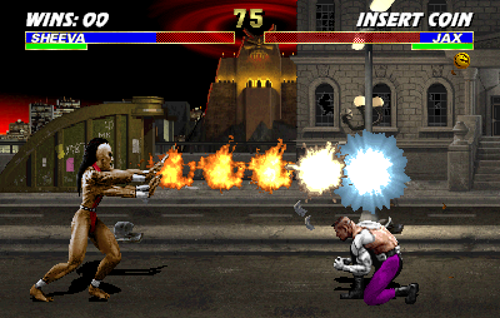
Cap’n Bogey’s was not caught empty-handed when Mortal Kombat 3 arrived. Three machines stood there perpetually mobbed, and even when I couldn’t play for half an hour it was enough to watch the new characters and fatalities. Sub-Zero was unmasked! The new ninja characters were cyborgs! Sheeva was basically a playable and female version of Goro or Kintaro, the previous games' sub-bosses! There was a new Run button on the console! And a weird masked dude with hook swords! And, uh…a riot cop. Named Kurtis Stryker.
It took a few weeks for us to realize that Mortal Kombat 3 was a letdown. The setting had moved from a gloomy and mystic Enter the Dragon stage to a blander post-apocalyptic Earth, the Run button added nothing, and the rest of the gameplay felt no different than Mortal Kombat II. Some of the new characters were okay, but we couldn’t look at Nightwolf or Stryker without wondering who the hell had decided to include a stereotypical Native American warrior and a doughy police officer in a jogging suit instead of favorites like Johnny Cage, Scorpion, or Kitana. Soon the arcade’s trio of cabinets dwindled to just one.
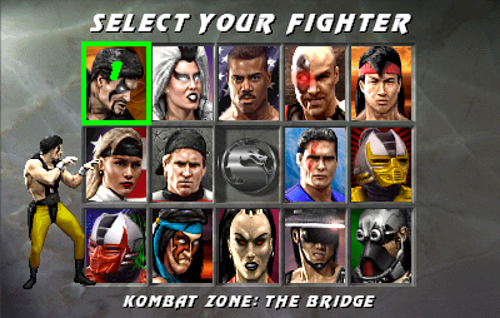
Even so, Mortal Kombat 3 was briefly important for me. Its most intriguing secret was a dragon symbol at the center of the character-select screen. On rare occasions, it would slide away to reveal the mask of a third robo-ninja. No one knew how to unlock him for a good while, but one day a kid brought a new magazine with a special code inside.
Mortal Kombat 3 allowed players to enter a password at certain points, though the window of time was small and it was hard to make sense of the symbols. The kid with the magazine couldn’t put in the code by himself, so I stepped in to help, whether the kid wanted it or not. Each of us entered half of the symbols, and this appeared.
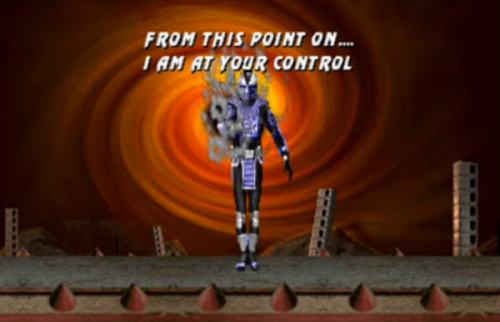
It was Smoke, a hidden character from Mortal Kombat II! He was a mecha-ninja now, and thanks in part to me, everyone at Cap’n Bogey’s could pick him in the game!
Like Mortal Kombat 3 itself, this was a fleeting accomplishment for me. Yet it was a legitimately inventive secret for an arcade game at the time, and it enshrined cyber-Smoke as a favorite Mortal Kombat character. Whenever I’d wander past the Mortal Kombat 3 cabinet on my way to play a fighting game I liked better, I’d get the tiniest blip of pride if someone was using Smoke.
STREET FIGHTER III
By all logic, Street Fighter III should have been the biggest fighting game of the 1990s. I’d been a fan of Street Fighter II since 1992, and even I though I had drifted away after the game’s numerous small upgrades (and I was hardly alone in this), I was lured back by the cartoonish overhaul and new characters of Street Fighter Alpha 2. And when Street Fighter III appeared in early 1997, I realized just how long I’d been waiting for it.
GameFan ran a gorgeous preview of the game, revealing that the cast was mostly all-new characters. Only Ryu and Ken returned, and while I was outraged at this snubbing of Chun-Li and Blanka, I was fascinated by the new lineup, which included a weird electric mutant, a one-armed hermit, and a ninja—something Street Fighter II always needed. I couldn’t wait to see the game in action, and I assumed everyone else felt the same.
I was old enough to have a license by this point, and when I heard Street Fighter III had arrived at Cap’N Bogey’s, it marked the rare occasion where I actually drove there instead of walking. I had to beat the crowds that would surely gather around every Street Fighter III cabinet and make it hard to even see the screen. I leapt from my hand-me-down Oldsmobile, bounded up the stairs, and looked for the throng of players.
A single Street Fighter III cabinet sat by the stairway. No one was playing it.
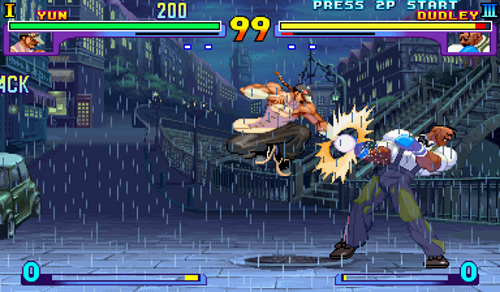
Baffled, I jumped right in. The game was impressive: gorgeous animation, fun new characters, and a system that let you select from different special moves for your character prior to each match. I tried out every character, picked out the Linn Kurosawa cameo in the hot-springs background, and just couldn’t understand why this game, this Street Fighter III that every kid had wanted more than world peace back in 1993, had no screaming masses surrounding it.
A few other kids joined in, and they seemed to like the game as well. One of them kept repeating that it would be a “worthy purchase” when it came to a home system.
That stuck with me. We had the PlayStation and Nintendo 64 and Sega Saturn, all of which could pull off decent versions of most arcade fighting games. And while Street Fighter III wouldn’t get a home port until the more powerful Dreamcast arrived, the lesson was clear: consoles had caught up to the arcade, at least as far as fighting games went, and most of us could afford to wait.
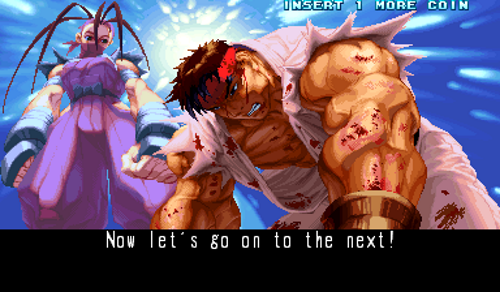
There were other reasons that Street Fighter III wasn’t as huge as I expected. The fighting game wave had crested, and while there would always be a devoted competitive following for the major titles, gone was the era when every game company from Irem to the makers of Golden Tee Golf tried their hand at a fighting game.
Cap’n Bogeys kept going, of course. I went off to college, but I’d visit it sometimes when I was back in town, and I was delighted to find that they sometimes had obscure Capcom arcade games like Tech Romancer and Rival Schools. I was usually the only one playing, though.
I’m not sure when Cap’n Bogey’s shut down. I remember it being there in 2002 with a sparse game selection that didn’t interest me beyond Capcom vs. SNK—which I’d already played on the Dreamcast. Arcades themselves were drying up by that point: the fighting game fervor was long over, and nothing had taken up the mantle. Patrons could enjoy elaborate racing-game cabinets or novelty plastic guns that they couldn’t find at home, but for the most part the kids who clogged up the arcade to play Mortal Kombat 3 or Killer Instinct were now too busy with an Xbox or PlayStation 2.
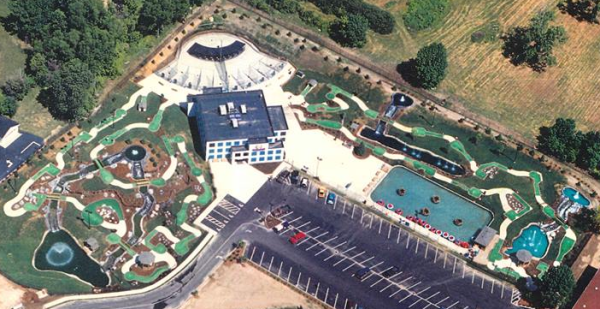
I cannot say if the downturn in arcades killed Cap’n Bogey’s Golf & Games. The captain still had his mini-golf, his bumper boats, his batting cages, and his wealth of novelty games to spit out tickets for overexcited children. Yet the day came when I stopped by and found Cap’n Bogey’s locked and deserted, and not long after the building was demolished to make way for a Wendy’s.
It's hard to find much information about Cap’n Bogey’s online: the photos here come from the D-X strip, a Facebook page, and some auctions. I regret that I never took any shots of the interior or the giant mustachioed mascot costume that an employee occasionally wore around the building. Like many childhood arcades, no one thought to document it until it was much too late. So if anyone reading this has particular memories or merchandise from this monument to mid-1990s arcades, feel free to share them.
And if you’re that kid who had the Smoke-unlocking code in Mortal Kombat 3, I’m sorry that I stole some of your glory.

No comments:
Post a Comment